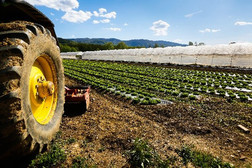|
Having trouble viewing this email? View it as a Web page.

|
|
|
Editor: Maggie Lawrence January 25, 2023


Agriculture is responsible for ensuring a safe and abundant food supply. For consumers, that means the products they see at the grocery store or farm market. Climate change, loss of land and competition for natural resources all present challenges for growing food.
Researchers at the University of Connecticut are exploring options to help ensure consumers have a safe, abundant and nutritious food supply. The project, which is studying a genetic editing technique in tomato plants, is funded by USDA’s National Institute of Food and Agriculture as part of the Biotechnology Risk Assessment Research Grant (BRAG) program. Read more here.
A University of Connecticut doctoral student examines his plants.
Photo courtesy of the University of Connecticut.
|
|
|

USDA to Create Plan to Expand Recreation Economies and Help People Thrive Across Rural America
The USDA has announced that it will create a plan to expand recreation economies to help people thrive across rural America.
Through a Memorandum of Understanding, Rural Development, the National Institute of Food and Agriculture and the U.S. Forest Service will partner to develop an annual plan to expand economic opportunities related to recreation in communities surrounding America’s national forests. Read more here.
Family bike riding in a forest, courtesy of Adobe Stock.
|

Registration Now Open for 2023 Agricultural Outlook Forum
USDA’s 99th Annual Agricultural Outlook Forum will be held in-person at the Crystal City Gateway Marriott Arlington, Virginia, from February 23-24, and all sessions will be livestreamed.
More than 30 sessions and 100 agriculture leaders and subject matter experts will discuss key issues impacting the sector. Learn more about the Forum and register here.
2023 USDA Agricultural Outlook Forum graphic.
|

National 4-H Conference Registration Open
Registration is now open for the 2023 National 4-H Conference in Washington, D.C. Bringing hundreds of 4-H’ers to the nation’s capital each spring, the National 4-H Conference is the flagship youth development opportunity of USDA. From April 14-19, the nationally recognized event is developing the next generation of leaders alongside more federal partners than ever before. Experience unparalleled discovery, learning, professional development and networking with 4-H’ers from around the world. The event features roundtable sessions, Youth Career Fair exhibitions, live “cool job” panels, community service, special events, assemblies and much more. Learn more and register online.
2023 National 4-H Conference “Join Us” graphic.
|

New SARE Publication Available to Farmers Seeking Organic Certification
Farmers and ranchers who want to pursue organic certification now have a new publication to help understand USDA National Organic Program requirements and key strategies producers can use to make their three-year transition to organic production a successful one.
Sustainable Agriculture Research and Education (SARE) recently published Transitioning to Organic Production. SARE is funded by USDA’s National Institute of Food and Agriculture. Read more.
Tractor in the field, courtesy of Adobe Stock.
Read More:
Impacts of NIFA-funded research and Extension programs on our blogs page.
|

NIFA Identifies NIH’s eRA System for Further Analysis
NIFA’s Grants Modernization Initiative (GMI) rang in the new year on a high note. Acting NIFA Director Dr. Dionne Toombs approved the internal Business Evaluation Team’s recommendation that the National Institutes of Health’s (NIH) eRA system be the grants management solution taken forward into GMI Phase 2: Fit/Gap Analysis. This marks a transition from broad evaluation to comprehensive analysis of every detail of our grants management systems. We will carefully define our current and desired business practices and map them to eRA to develop a vision for the future of NIFA’s grants management operations. This is an exciting time to reimagine how we do business to strengthen our capabilities and improve the lives of our customers, stakeholders, and staff.
Thank you to our customers and stakeholders who provided feedback thus far on GMI. We continue to welcome your feedback by sending your comments, questions or concerns about NIFA’s current grants managements systems or the grants management system NIFA is considering adopting in the future (NIH/eRA) to NIFAGrantsMod@usda.gov.
Grant Modernization NIFA graphic.
|

SBIR/STTR FY23 Phase II RFA Technical Assistance Webinar
On February 16 from 2 to 3 p.m. EST, NIFA program staff will provide an overview of Phase II of NIFA's Small Business Innovation Research and Small Business Technology Transfer programs.
The programs’ Phase II funding opportunity, open only to previous Phase I awardees who have not already applied for a Phase II grant, focuses on continuing the research and development undertaken in Phase I with a goal of commercialization — bringing the innovation to market as the Phase II project completes. Learn more and register here.
NIFA webinar graphic.
|

Circadian Clock Controls Sunflower Blooms, Optimizing for Pollinators
An internal circadian clock controls the distinctive concentric rings of flowering in sunflowers, maximizing visits from pollinators, a new study from plant biologists at the University of California, Davis, shows. The work is published January.13 in eLife.
As farmers adapt to a changing climate, it will become increasingly important to make pollination as efficient as possible in crops that require it. Understanding how the circadian clock and the environment affect flowering will help breeders develop cultivars that flower at the optimal times of day to promote pollination, despite climate change and declining insect populations. Read more here.
Blooming sunflower, courtesy of Adobe Stock.
|

USDA Invests $25 Million to Expand Healthy Incentives in SNAP
The USDA’s Food and Nutrition Service (FNS) is improving access to fruits and vegetables by expanding the Supplemental Nutrition Assistance Program, also known as SNAP, healthy incentive initiatives. This year, FNS will select up to three states to receive funding and support to run an Electronic Healthy Incentives Pilot, or eHIP, for SNAP participants in their state. Read more here.
USDA graphic symbol.
Visit USDA for additional USDA news.
|

USDA recently announced it will create a plan to expand recreation economies to help people thrive across rural America.
|

We are thrilled to announce that Drenda Williams is now serving as NIFA’s Associate Director for Operations.
In this role, she will provide oversight of the agency's operations for a workforce of over 340 employees and an operating budget above $100 million.
Since May 2020, Drenda has served NIFA as the Director of Equal Opportunity and Civil Rights, Acting Associate Director of Operations and Acting Senior Policy and Operations Officer, making significant agency impacts in civil rights, operations, policy, and diversity, equity, inclusion and accessibility. Read more.
|
|
|
|
NIFA’s mission is to invest in and advance agricultural research, education, and Extension that solves societal challenges. NIFA’s investments in transformative science directly support the long-term prosperity and global preeminence of U.S. agriculture. Keep informed about NIFA, USDA, our Land-grant and non-Land-grant university partners, and stakeholders with the NIFA Update. Read past issues online, sign up for email updates or follow us on Twitter @USDA_NIFA, #NIFAImpacts or LinkedIn @usda-nifa.
If you wish to submit a news item or information, send an email to NIFAUpdate.
USDA is an equal opportunity lender, provider, and employer.
|
|
|
|